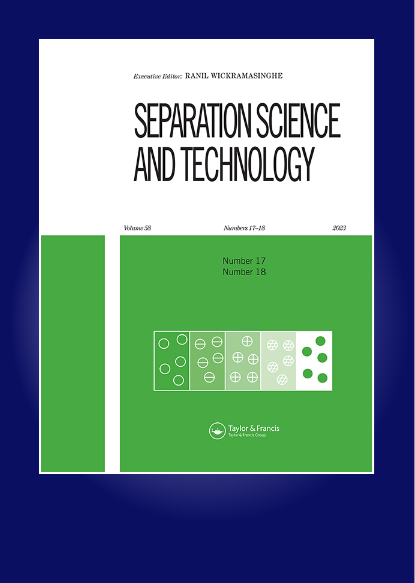利用新型三电分离法从二次铝灰中回收 AlN
IF 2.3
4区 工程技术
Q3 CHEMISTRY, MULTIDISCIPLINARY
引用次数: 0
摘要
摘要 二次铝灰是铝工业的副产品,含有氮化铝(AlN)和氧化铝(Al2O3)等有价值的成分。氮化铝具有优异的热性能和电性能,被广泛应用于各种领域,因此从二次铝灰中回收氮化铝对经济和环境都至关重要。在本研究中,我们通过研究二次铝灰的主要成分 Al2O3 和 AlN 的三次充电特性,开发了一种新型的三次电分离技术,用于从铝灰中回收 AlN。我们使用聚四氟乙烯(PTFE)、聚丙烯(PP)、聚氯乙烯(PVC)、铜(Cu)和不锈钢(SS)等不同材料作为三电材料,研究了三电球比、摩擦时间和搅拌速度对纯 Al2O3 和 AlN 三电的影响。我们还研究了摩擦介质球比、摩擦介质材料、转速和电压对三电分离过程的影响。结果表明,在使用 PTFE 球、1:5 摩擦介质球比、290 n/min 搅拌速度和 30 s 三电持续时间时,Al2O3 和 AlN 的电荷质量比分别为 1.96 和 -15.56 nC/g,差异最大。要从铝灰中回收 AlN,应选用 PTFE 作为摩擦介质,摩擦介质球比为 1:3,转速为 50 rpm,电压为 40kV,这样 AlN 的品位可达 89.25%,正负电极中 AlN 的回收率也显著提高。我们的研究结果证明了有效分离 Al2O3 和 AlN 的可行性。本文章由计算机程序翻译,如有差异,请以英文原文为准。
Recovering AlN from secondary aluminum ash using a novel triboelectric separation
ABSTRACT Secondary aluminum ash is a byproduct in the aluminum industry that contains valuable components, such as aluminum nitride (AlN) and aluminum oxide (Al2O3). AlN has excellent thermal and electrical properties and is widely used in various applications, making the recovery of AlN from secondary aluminum ash essential for both economic and environmental reasons. In this study, we developed a novel triboelectric separation technique to recover AlN from aluminum ash by investigating the tribocharging characteristics of the main components of secondary aluminum ash, Al2O3 and AlN. We studied the effects of tribocharging ball ratio, friction time, and stirring speed on the tribocharging of pure Al2O3 and AlN, using various materials such as polytef (PTFE), polypropylene (PP), polyvinyl chloride (PVC), copper (Cu), and stainless steel (SS) as tribocharging materials. We also examined the effects of friction medium ball ratio, friction medium material, rotational speed, and voltage on the triboelectric separation process. Our results showed that the charge-to-mass ratio for Al2O3 and AlN was 1.96 and −15.56 nC/g, respectively, the difference is largest, with a PTFE ball, a 1:5 ratio, a stirring speed of 290 n/min, and a tribocharging duration of 30 s. The triboelectric sequence of these friction materials was (+)PTFE, PP, Al2O3, SS, Cu, PVC, and AlN (-). To recover AlN from aluminum ash, PTFE should be chosen as the friction medium, and a friction medium ball ratio of 1:3, rpm rotation speed of 50, and voltage of 40kV should be used, resulting in an AlN grade of 89.25% and a significant increase in the recovery rate of AlN in the positive and negative electrode. Our findings demonstrate the feasibility of effective triboelectric separation of Al2O3 and AlN.
求助全文
通过发布文献求助,成功后即可免费获取论文全文。
去求助
来源期刊

Separation Science and Technology
工程技术-工程:化工
CiteScore
6.10
自引率
3.60%
发文量
131
审稿时长
5.7 months
期刊介绍:
This international journal deals with fundamental and applied aspects of separation processes related to a number of fields. A wide range of topics are covered in the journal including adsorption, membranes, extraction, distillation, absorption, centrifugation, crystallization, precipitation, reactive separations, hybrid processes, continuous separations, carbon capture, flocculation and magnetic separations. The journal focuses on state of the art preparative separations and theoretical contributions to the field of separation science. Applications include environmental, energy, water, and biotechnology. The journal does not publish analytical separation papers unless they contain new fundamental contributions to the field of separation science.
 求助内容:
求助内容: 应助结果提醒方式:
应助结果提醒方式:


